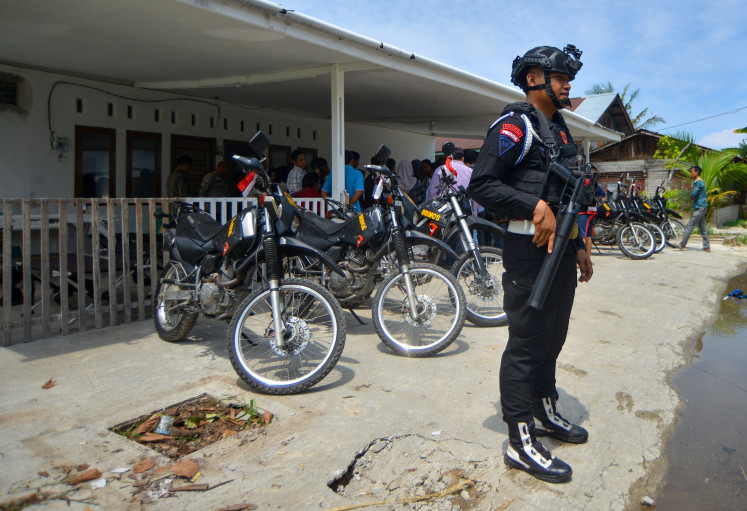Popular Reads
Top Results
Can't find what you're looking for?
View all search resultsPopular Reads
Top Results
Can't find what you're looking for?
View all search resultsKartika Affandi: Giving Indonesia another perspective
Laughing out loud: Painter and sculptor Kartika Affandi congratulates Azam Bachtiar on his work
Change text size
Gift Premium Articles
to Anyone
Laughing out loud: Painter and sculptor Kartika Affandi congratulates Azam Bachtiar on his work.
It’s clear that renowned painter and sculptor Kartika Affandi, who just turned 85 in November, has been boisterously independent for all eight decades of her life.
Kartika Affandi claims she’s ugly. She was also raised to be truthful.
Let’s settle the conundrum.
To push her point she adds makeup and fractures another taboo. Instead of masking womanly mysteries by preening in private, she steers her wheelchair into the open, opens her box of tricks and faces her fans.
The voyeurs seek more than rouge, red chili ear danglers and an upturned clown mouth. Deceptions or pointers?
They strive to catch character on canvas and the best succeed with wild swirls of color and shades of darkness. Their model has got to that certain age where she no longer cares a damn what anyone thinks. Or maybe it’s always been that way.
There’s no brashness, nothing unkind. Her eccentricity is benign. It’s not a gimmick, though it might be a shield against past pains: “I’m doing this not to look beautiful, although I enjoy people looking at me,” she said. “I want to get rid of bad spirits, to help us all enjoy life.”
The Yogyakarta painter and sculptor turned 85 in November; it’s clear she’s been boisterously independent for all eight decades.
When her famous father Affandi told the only child from his first marriage with artist Maryati: “What a pity you’re my daughter”, she could have sulked at best or become a psychotic mess.
Instead she replied: “I’m glad I’m a woman, though I know it’s easier to be a man in Indonesia. And that’s wrong. I want equality.”
Does she get angry? “Sometimes. Then I walk away. Or paint. Move on. There’s no place for hate.”
Yet some of her self portraits look so tortured they could be used in campaigns against domestic violence.
In life she’s frothy female, laughing to offset the feminist messages that make insecure men fold their legs.
Affandi erased his disappointment and set about teaching his tough little girl to be original and “never tell lies; don’t just see, but feel”.
Kartika squeezed her first paint tube when she was 7 and has since exhibited in Europe, South America, the United States and Australia where she painted with Aboriginal women in the central desert town of Alice Springs.
“I want to be outdoors, among people where they live,” she said. “I’ve worked in Amsterdam’s red light district and a mental hospital. I went to Aceh to be with the survivors. Art is therapy.”
All good — but in Indonesia tall poppies need the scythe.
Work in progress: Sadikin Pard (left), one of the country’s leading mouth and foot painters, works on his portrait of Kartika Affandi.Astri Wright, a Canadian art historian, has written that Kartika “paid with social ostracization and sexist reviews for presuming to become a modern artist” and “for painting too much like her father”.
In The Jakarta Post, author Julia Suryakusuma described Kartika as “an antidote to state ibu-ism (state motherhood), the New Order militaristic, feudal Javanese social construction of womanhood whereby women were defined as appendages to their husbands”.
Despite her colorful past — or maybe because of it — Kartika reluctantly acknowledged she’s better celebrated outside her homeland.
A biography in English by Dutch poet Barney Agerbeek is scheduled for November 2020. The documentary Kartika: 9 Ways of Seeing by Christopher Basile, an American in Australia, was released in 2018. She said it has yet to be shown in Indonesia.
The girl from Jakarta soon kicked the dust of orthodox Java off her sandals. By 18 she was a pregnant student in London with her older artist lover Saptohoedojo. She’d already studied in India on a government scholarship for exceptional children, but knew little about making babies.
The couple couldn’t find a mosque so used a registry office. Eight children and 20 years later they divorced after battling Islamic authorities claiming they weren’t married.
“I was fed up with his polygamy,” she said. “A partnership can only hold together if there’s trust and honesty. The rest is bullshit.”
A second union with Austrian Gerhard Koberl came and went. She ponders proposing to her older Australian academic “boyfriend” who lives in Melbourne. Although they’ve known each other for 55 years “that’s not the same as living together. I don’t want another divorce. Maybe I’m difficult”.
If so there was no annoyance on show as she held court for four hours in the garden of Malang artist and author Bambang Adrian Wenzel. A dozen painters and sketchers gripped brushes to capture more than a “mish mash” of her complex personality.
True spirit: Kartika Affandi models in makeup for painters in the garden of artist and author Bambang Adrian Wenzel in Malang, East Java.Two of the more successful in “getting to see what I think” were Azam Bachtiar and Sadikin Pard. Their tangled lines forming a whole, abstract other world image let the viewer peer behind the paint.
Pard is one of the nation’s leading mouth and foot painters, and has just opened a gallery in the East Java city.
Kartika also has one in Yogyakarta honoring her father who died in 1990. The New York Times called him “Indonesia’s foremost Expressionist painter […] whose works were exhibited worldwide”. Apart from being an artist he also supported first president Sukarno — and for this he and his family’s movements were restricted for six weeks in 1948 by the Dutch.
“The Sukarno years were the golden era of Indonesian art,” she said. “He appreciated my father’s work. He was a good man but his main fault was polygamy. Under [former president] Soeharto, the military was worshipped more than humanity.
“So many Indonesians don’t go to galleries because they feel shame. That’s so sad. We need art education in schools so children can appreciate the importance of culture and expressing the imagination.”
Kartika said she spent 40 years as a Buddhist “but now I really don’t know about religion […] I just want to be a good person and be honest to myself. I accept gays and lesbians — everyone. I try to encourage women to show their creativity. Art helps us live better, to have spirit.”
How should her obituary read? “I gave Indonesia another perspective of the quality of life.” (ste)
— Photos by Erlinawati Graham












